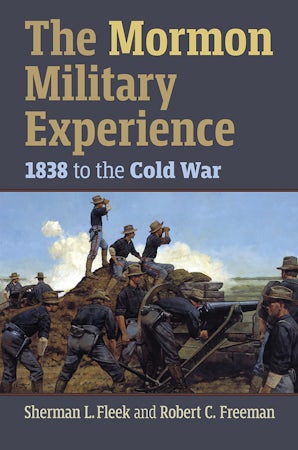
Review
Title: The Mormon Military Experience: 1838 to the Cold War
Author: Sherman L. Fleek and Robert C. Freeman
Publisher: Kansas University Press
Year Published: 2023
Pages: 357
Format: Hardback
Genre: Military History, Religious History
ISBN: 9780700634323
Price: $38.77
Reviewed by Kevin Folkman for the Association for Mormon Letters
During the 1838 troubles in Missouri, The Church of Jesus Christ of Latter-day Saints organized and fielded militias in defense of their homes and property, becoming the only religious organization in US history to arm and field military forces in service of their faith, write authors Sherman Fleek and Robert Freeman in The Mormon Military Experience: 1838 to the Cold War. Such religiously centered military operations have been treated in bits and pieces elsewhere, but Fleek and Freeman’s book is the first comprehensive look at this unique segment of LDS and US history.
The authors treat this experience purely in military terms, writing about the organization and leadership of militias, including the Nauvoo Legion, the Mormon Battalion, the Danites, territorial militias in Utah prior to statehood, and Utah National Guard units down to the present time. As a retired Army officer and historian at the US Military Academy at West Point, Fleek brings a sharp eye and specific knowledge of the subject to this little-explored story. What it is not is the more detailed stories of individual church members’ war experiences, such as the Saints at War series to which Freeman has contributed. Individual members’ experiences are touched upon, but not in as much detail as some readers would like.
Fleek and Freeman use their knowledge to draw comparisons between Mormon military history and American military organization and history. They show, for example, how the original Nauvoo Legion and its unique size and leadership differed from other state militias in Illinois and elsewhere at the time. Rather than the members of the militia electing their own officers as was common practice, the LDS church leadership appointed officers from within church leadership, even granting church president Joseph Smith, Jr the rank of Lieutenant General, equivalent to the highest rank of any army officer in the regular US army at the time. Nauvoo-era units were top-heavy with officers chosen from church leaders, and training mostly centered on marching and ceremonial duties rather than combat operations. The authors show how this practice continued on down through the Utah territorial militias prior to statehood in 1896.
Subsequent chapters focus on the Mormon Battalion, the Utah War, conflict with Indian tribes, the Spanish-American War, and on into the world wars and cold war of the 20th century. Topics also include the Church’s position on war in general, pacifism by members and leaders, and the transition from church-organized militias to integration with the Army, Air Force, and Naval reserve units. There is also information regarding LDS soldiers in other countries, particularly in Europe during World War II, where church members fought on both sides. This reflected the faith’s 12th Article of Faith, affirming members’ obligation to respect and support the governments under which they serve and sustain the laws of the land. I particularly enjoyed the chapter that described the internal debate by LDS church leadership leading to a statement opposing the deployment of the MX nuclear missile arsenal in the Great Basin deserts of Utah and Nevada. As Fleek and Freeman write, while the church recognized the need for a robust national defense, there were larger concerns over the social and environmental impacts of the massive project, along with concerns about the proliferation of nuclear weapons worldwide.
There were a few arguments made by the authors that deserve scrutiny. Fleek and Freeman point to the Spanish-American War of 1898 as the catalyst that ended Mormon exceptionalism and brought Utah into the national mainstream. Most scholars of Mormon History would place the Columbian Exposition (Chicago World Fair) of 1893 as a turning point in the effort by the Church and the State of Utah to present a mainstream and patriotic image to the nation and the world.[i] Certainly, Utah citizens and church members who served in Cuba and the Philippines came back with a more expansive worldview, but it was another step in a process already begun with the announced end of polygamy in 1890. Similarly, there is no mention of the US military presence in Siberia and Northern Russia that began towards the end of WWI in 1918 and continued beyond the armistice into 1920 involving significant numbers of LDS soldiers.[ii]
It also needs to be noted that there are an inordinate amount of what appear to be typographical or proofreading errors in the manuscript. In any volume of hundreds of pages and tens of thousands of words, it would be surprising to not find a few such errors. However, there were too many to ignore in The Mormon Military Experience. The most significant for me is found in the opening paragraph of chapter 5 about the Utah War. That paragraph states the first word that Brigham Young had of the pending invasion by the regular Army occurred in July 1847, rather than 1857 while the Saints were celebrating the tenth anniversary of their arrival in Utah. In addition, there are many other errors including duplicate words, incomplete sentences, and what appear to be missing letters. One or two of these are excusable; multiple instances become distracting.
Overall, The Mormon Military Experience can be an important addition that highlights subject matter not given full treatment elsewhere. Fleek and Freeman end their book by writing that the involvement of LDS soldiers in Middle Eastern and other 21st-century conflicts are too recent and needs further reflection and study, opening up opportunities for further research into the complex relationship between religion and military service.
[i] Konden Smith Hansen, “Frontier Religion: Mormons in America, 1857 – 1907,” 2019, University of Utah Press
[ii] Folkman and Ballard, “Just Like the Mountains of Tennessee and Virginia: LDS Soldiers in Siberia, 1918-1919,” Journal of Mormon History, Volume 41 No. 2
